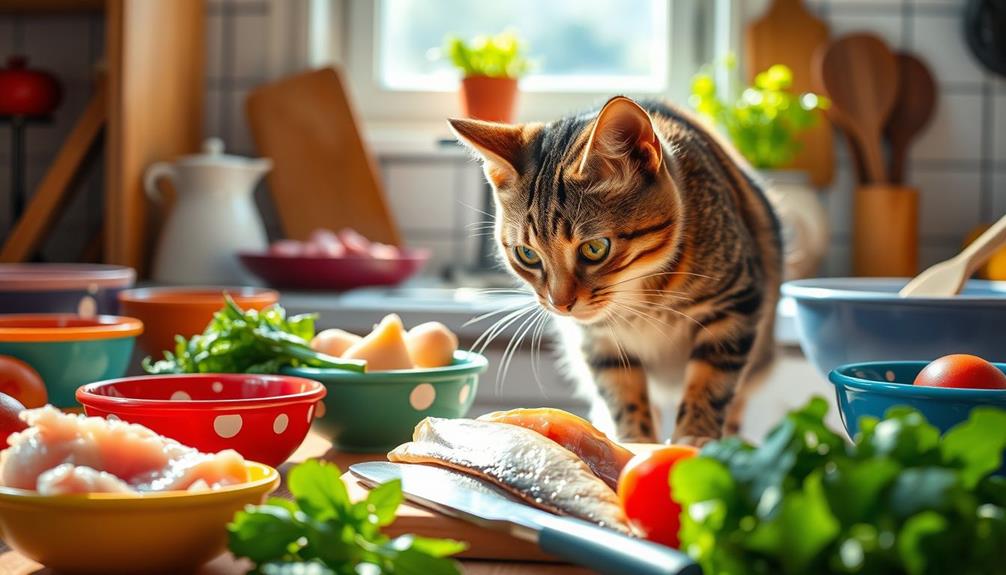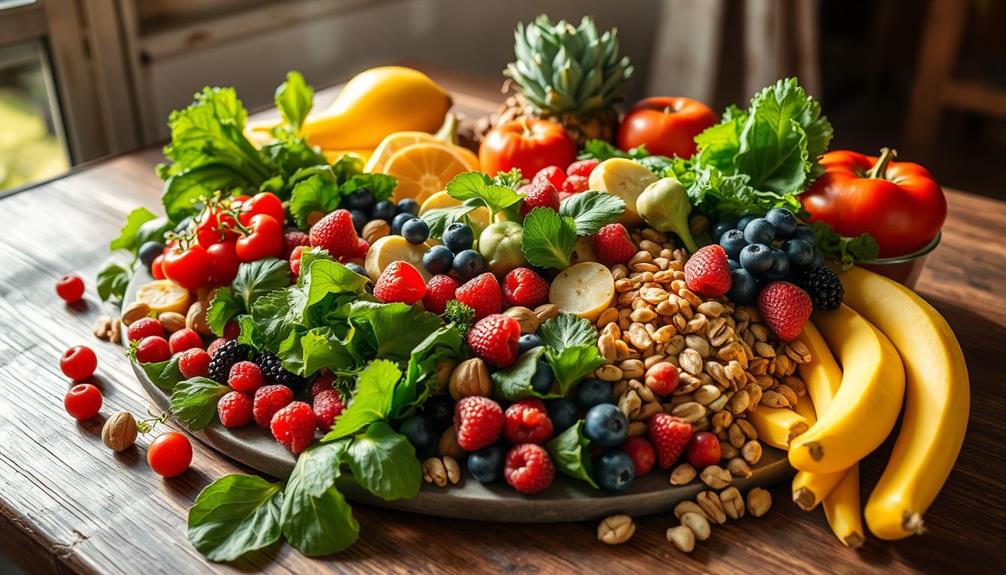To introduce raw food to your cat, start slowly over 7-10 days. Begin with a mix of 75% old food and 25% raw, gradually increasing the raw portion. Always choose high-quality, human-grade meat and prepare it safely by defrosting in the fridge to avoid bacteria. Feed during peak hunger times to encourage acceptance, and monitor your cat's reaction throughout the shift. It's also helpful to establish regular feeding times to create a routine. This way, you'll make the switch smoother and more enjoyable for your furry friend, and you'll discover more tips to guarantee success. Remember to always consult with your veterinarian before making any major changes to your cat’s diet, as they can provide valuable guidance and ensure your cat’s nutritional needs are being met with the introduction of raw food. There are many benefits to feeding raw food for cats, such as improved digestion, healthier skin and coat, and increased energy levels. By taking the time to slowly transition and following these tips, you can successfully incorporate raw food into your cat’s diet, leading to a happier and healthier pet.
Key Takeaways
- Gradually transition over 7-10 days by starting with a mix of 75% old food and 25% raw food.
- Monitor your cat's reaction and adjust ratios based on their acceptance and any digestive issues.
- Introduce raw food during peak hunger times to encourage acceptance and increase interest.
- Ensure all raw food meets your cat's specific nutritional needs, incorporating organ meats for added nutrients.
- Establish a consistent feeding schedule and promptly refrigerate any uneaten raw food to maintain hygiene.
Preparing Raw Food Safely
Preparing raw food for your cat safely is vital to guarantee their health and well-being. When you decide to switch to a raw food diet, it's important to follow specific guidelines to make sure your cat's safety.
Always defrost raw food in the refrigerator for about 24 hours to prevent bacterial growth, as improper handling can lead to health issues similar to those seen in small pets like hamsters. Avoid using a microwave, as it can make bones brittle and pose a danger to your obligate carnivore. For further details on safe diets for small animals, check out ultimate hamster care.
If you need a quicker method, you can defrost unopened tubs of raw food in cool water for about one hour. If it's still cold, you can mash it in hot water or bone broth before serving. Remember to source high-quality, human-grade meat to minimize contamination risks.
Additionally, practice safe storage practices by keeping raw meals in sealed containers, and always clean feeding utensils after each use. This helps prevent cross-contamination and maintains hygiene.
Transitioning to Raw Diet
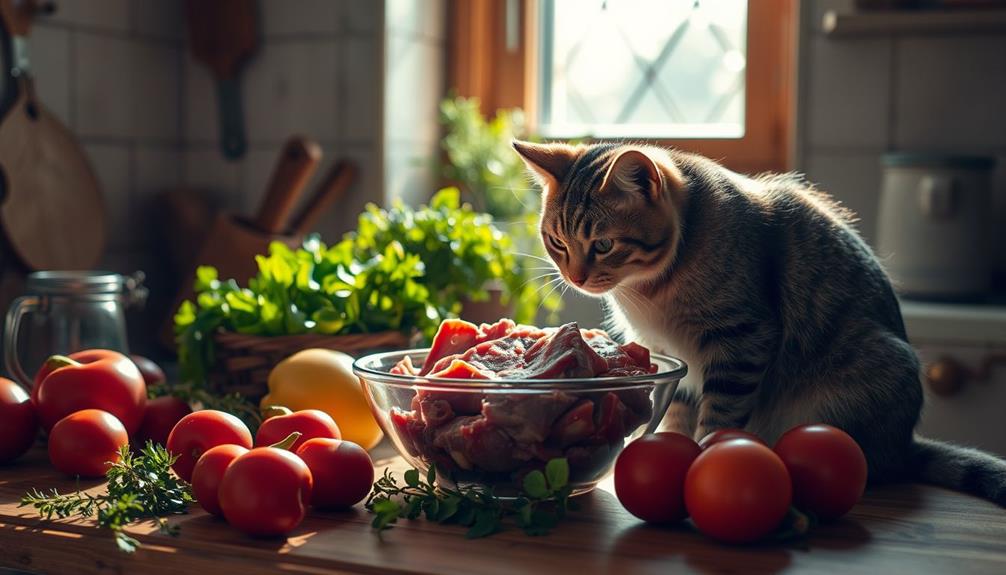
Once you've got the safe preparation of raw food down, it's time to shift your cat to this new diet. A gradual change is key to successfully introducing raw food into your cat's diet. Typically, this process should take about 7-10 days.
Start with a mix of 75% old food and 25% raw food, adjusting the ratios every few days until you reach 100% raw. It's also important to guarantee that the raw food is balanced and appropriate for your cat's nutritional needs, as some cats may have specific dietary requirements cold medications overview.
During this change, it's crucial to monitor your cat's reaction. Some cats adapt quickly, while others, especially older ones, may need more time.
Here are some tips to help you transition your cat effectively:
- Introduce raw food during peak hunger times.
- Avoid leaving uneaten food out to prevent spoilage.
- Consider using nutritional yeast to enhance the new food's appeal.
- If digestive issues arise, extend the transition period.
Nutritional Benefits for Cats
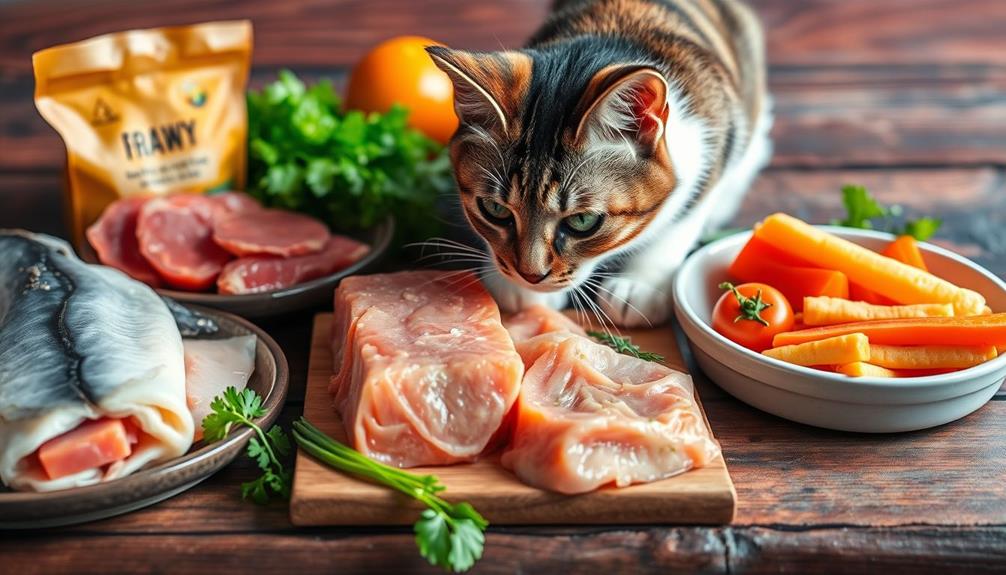
A raw food diet offers numerous nutritional benefits that can greatly enhance your cat's health. By incorporating raw food into your cat's diet, you provide essential amino acids, like taurine, which are essential for heart and eye health. Including organ meats boosts nutrient density, supplying vitamins and minerals that support overall well-being.
Here's a quick overview of some key nutritional benefits:
| Nutritional Benefit | Description |
|---|---|
| Amino Acids | Essential for heart and eye health |
| Organ Meats | Rich in important vitamins and minerals |
| Improved Digestion | Natural ingredients reduce gastrointestinal issues |
| High Protein | Supports energy levels and lean body mass |
| Enhanced Coat Condition | Leads to shinier fur and better skin health |
With a high protein content, raw food helps maintain your cat's energy levels and reduces the risk of obesity. Regular consumption can also improve coat condition and skin health, resulting in a shinier appearance and fewer skin irritations. Shifting to a raw food diet can be a rewarding choice for your feline friend, bringing numerous health benefits that contribute to their overall wellness.
Common Misconceptions Debunked
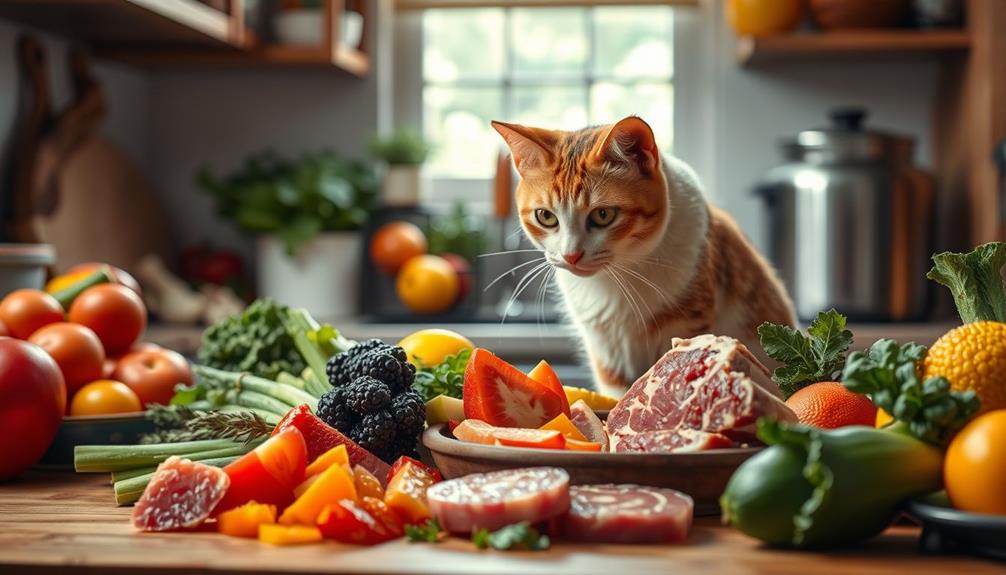
Many cat owners hesitate to switch to a raw food diet due to widespread misconceptions. These myths can prevent your cat from enjoying the benefits of a well-balanced raw diet. Here are some common misconceptions you should know:
– Raw diets are unsafe: With proper handling and high-quality ingredients, feeding your cat raw food can be safe and beneficial.
Additionally, understanding the importance of a balanced diet rich in fruits and vegetables can enhance your cat's overall health.
- Cats won't get enough nutrients: A well-balanced raw diet, especially one including organ meats, can meet all your cat's nutritional needs.
- Raw diets cause aggression: There's no scientific evidence linking raw food to aggressive behavior in cats.
- Adjusting is quick and easy: Adapting your cat to raw food often requires a gradual approach and patience.
Understanding these misconceptions can help you make informed decisions about adapting your cat to raw food.
By choosing reputable products and ensuring a balanced diet, you can provide your feline friend with a nutritious and enjoyable eating experience.
Tips for Successful Feeding
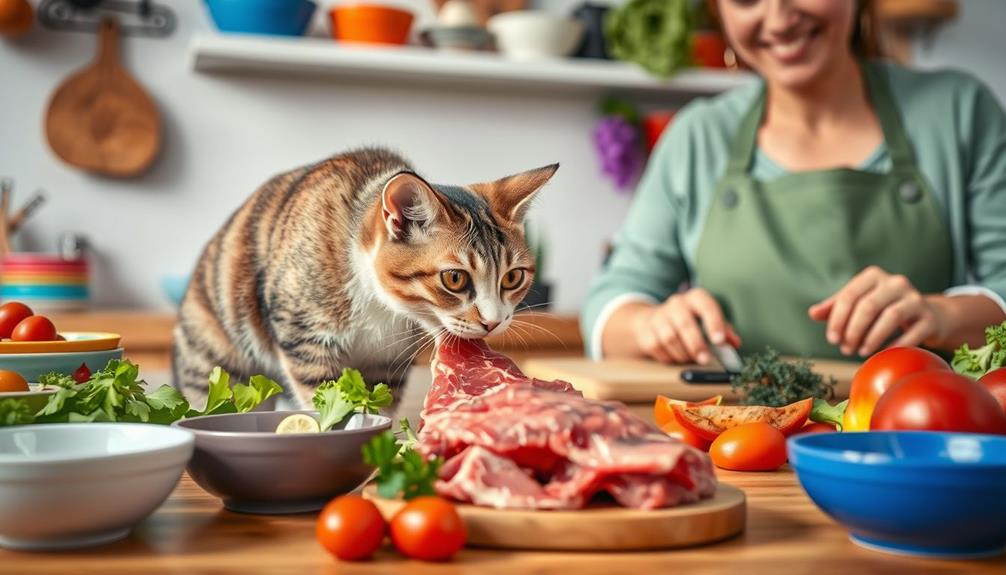
Introducing raw food to your cat can be a rewarding journey, but it requires careful planning and patience. Start by establishing a consistent feeding schedule to help reduce anxiety and create a routine during the change.
Gradually introduce raw food by mixing it with your cat's current kibble or wet food. You can use either the one bowl or two bowl method, allowing your cat to adjust to the new diet for your cat without overwhelming them. Incorporating natural ingredients in their diet, much like healthy dog snacks, can enhance overall health and wellness.
As you implement this change, monitor your cat's reactions closely. Adjust portion sizes based on their weight and activity level; this alteration can take up to two weeks or even longer for some cats.
To enhance the appeal of raw food, incorporate nutritional yeast, which can stimulate your cat's appetite and make meals more enticing.
Remember to always refrigerate any uneaten raw food promptly to prevent spoilage and maintain hygiene in your feeding practices.
Frequently Asked Questions
How to Introduce Raw Food to a Cat?
To introduce raw food to your cat, start with a grain-free kibble. Gradually mix in raw food over 7-10 days, monitoring their response closely and adjusting the ratio as they adapt to the new diet.
Can I Feed My Cat Raw in the Morning and Kibble at Night?
Feeding your cat raw food in the morning and kibble at night can work like a well-tuned clock. Just guarantee the raw meal's balanced, watch for their reactions, and maintain a consistent routine for best results.
How Do I Transition My Cat From Wet to Raw Food?
To shift your cat from wet to raw food, start by mixing 25% raw with 75% wet. Gradually adjust the ratios over 10 days, monitoring your cat's response to guarantee a smooth change.
Is Raw Food Good for Indoor Cats?
Imagine your cat thriving like a wild hunter! Raw food's packed with essential nutrients and hydration, supporting heart health, weight management, and digestion. It can transform your indoor feline into a vibrant, energetic companion.
Conclusion
Incorporating raw food into your cat's diet can be a game changer for their health. By safely preparing raw meals and shifting gradually, you'll help them thrive while debunking common misconceptions along the way. Remember, every cat is unique, so it may take time to find the right balance. With a bit of patience and persistence, you'll be on the fast track to a happier, healthier feline companion. So, why not take the plunge today?

